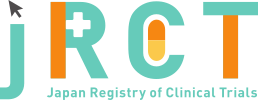臨床研究等提出・公開システム
|
Feb. 19, 2024 |
|
|
May. 01, 2025 |
|
|
jRCTs031230645 |
JCOG2215: A randomized controlled phase III trial comparing endoscopic balloon dilation alone versus endoscopic balloon dilation with local triamcinolone injection for esophageal stricture after endoscopic submucosal dissection for esophageal cancer (ACCELERATE trial) |
|
JCOG2215: A randomized controlled phase III trial comparing endoscopic balloon dilation alone versus endoscopic balloon dilation with local triamcinolone injection for esophageal stricture after endoscopic submucosal dissection for esophageal cancer (ACCELERATE trial) |
Yano Tomonori |
||
National Cancer Center Hospital East |
||
6-5-1, Kashiwanoha, Kashiwa-shi, Chiba,277-8577 Japan. |
||
+81-4-7133-1111 |
||
toyano@east.ncc.go.jp |
||
Kadota Tomohiro |
||
Department of Gastroenterology and Endoscopy, National Cancer Center Hospital East |
||
6-5-1, Kashiwanoha, Kashiwa-shi, Chiba,277-8577 Japan. |
||
+81-4-7133-1111 |
||
tkadota@east.ncc.go.jp |
Recruiting |
Feb. 19, 2024 |
||
| Mar. 15, 2024 | ||
| 260 | ||
Interventional |
||
randomized controlled trial |
||
open(masking not used) |
||
active control |
||
parallel assignment |
||
treatment purpose |
||
1st inclusion criteria |
||
(1) Active infection requiring systemic therapy. |
||
| 18age old over | ||
| No limit | ||
Both |
||
Esophageal stricture after endoscopic submucosal dissection for esophageal cancer |
||
Arm A: Endoscopic balloon dilation for the post-ESD esophageal stricture. |
||
Time to post-ESD esophageal stricture resolution |
||
Proportion of patients who required rescue EBD, Number of endoscopic balloon dilation for 24 weeks, proportion of patients with dysphagia score 0 at the time of 24 weeks after treatment, adverse events, PRO-CTCAE (difficulty swallowing, decreased appetite, nausea, vomiting, heartburn) |
||
| National Cancer Center Japan | |
| Not applicable |
| National Cancer Center Hospital East Certified Review Board | |
| 6-5-1 Kashiwanoha, Kashiwa, Chiba | |
+81-4-7133-1111 |
|
| ncche-irb@east.ncc.go.jp | |
| Approval | |
Dec. 20, 2023 |
Yes |
|
Individual patient-level-data will be provided only when the data is used in collaborative research with JCOG researchers and after the primary analysis result of this tral is published. The JCOG study group chair will make the final decision whether data sharing should be accepted or not. Data sharing information will be released at the JCOG website. JCOG Data Center will receive program, log, and output for the analysis. |
none |
